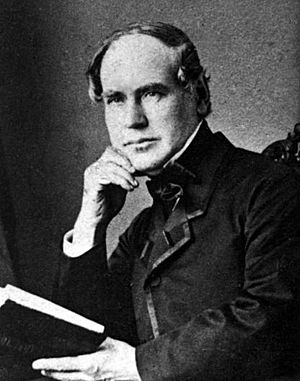Édouard de Verneuil facts for kids
Philippe Édouard Poulletier de Verneuil (born February 13, 1805 – died May 29, 1873) was a famous French paleontologist. A paleontologist is a scientist who studies fossils to learn about ancient life on Earth.
Contents
Early Life and Interest in Science
Édouard de Verneuil was born in Paris, France. He first studied law, but he was very interested in science. He had enough money to follow his passion. He started attending lectures on geology, which is the study of Earth's rocks and history. These lectures were given by a well-known scientist named Jean-Baptiste Elie de Beaumont. Édouard de Verneuil quickly fell in love with geology and decided to dedicate his life to it.
Exploring Europe's Geology
De Verneuil spent many years traveling across Europe. He wanted to learn more about the Earth's history.
- He explored the geology of the Crimea region. He even wrote an essay about what he found there in 1837.
- Next, he studied the rocks and fossils from the Devonian period in an area called Bas-Boulonnais. The Devonian period was a time long ago, about 419 to 359 million years ago.
- In 1839, he joined two other famous geologists, Adam Sedgwick and Roderick Murchison. They studied very old rocks from the Palaeozoic Era in Germany and Belgium. He shared his fossil findings with the Geological Society of London.
Discoveries in Russia and Beyond
Édouard de Verneuil's work became very important.
- When Roderick Murchison started studying the geology of the Russian Empire, he asked de Verneuil to join him.
- De Verneuil's discoveries were included in a major book called The Geology of Russia in Europe and the Ural Mountains (1845).
- Later, de Verneuil traveled to the United States. He wanted to learn about the ancient rocks there. His findings were published in 1847.
- He also went on many trips to Spain. His observations helped create a geological map of Spain and Portugal in 1864. He worked on this map with Edouard Collomb.
Awards and Recognition
De Verneuil's hard work and important discoveries were recognized by other scientists.
- In 1853, he received the Wollaston Medal from the Geological Society of London. This is a very important award for geologists.
- In 1860, he was chosen as a foreign member of the Royal Society. This is a group of top scientists in the United Kingdom.
- He also served as President of the Geological Society of France three times: in 1840, 1853, and 1867.
Legacy
Édouard de Verneuil died in Paris in 1873. His work helped us understand more about Earth's ancient past. A type of fossil, a deformed brachiopod, was named after him. It is called Cyrtospirifer verneuili. This fossil is sometimes known as the "Delabole Butterfly" by quarry workers. Brachiopods are small sea creatures with two shells, similar to clams.


